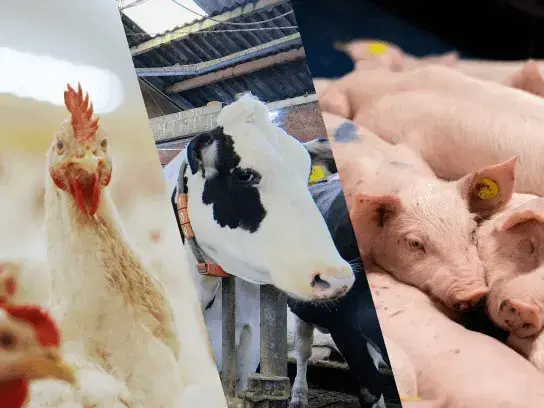- Poultry
- Parent Stock
- 3 minutes read
When Ruud took over the family farm seven years ago, it wasn’t a sudden move. After working elsewhere for a while, he gradually started helping out a few days a week — until he eventually took the reins full time. Now, years later, he’s navigating one of the biggest shifts the farm has seen: the switch to Hubbard parent stock.
But not without challenges...
A Long History with HATO
Even before Ruud teamed up with lighting specialist Max Obers and zootechnician Henk Rodenboog from De Heus, his barns were already equipped with HATO lighting. The setup? An earlier generation of CORAX lamps installed between 2012 and 2015 — warm white light only, with iconic orange covers.
Despite being over a decade old, these lights still worked well. But with the introduction of the DDS lamp, Ruud had the chance to level up his lighting strategy.
Unlike the older models, the DDS lamp allowed blending of warm white and cold white light, while UV-A was always active. This was a game-changer, especially when managing new bird behavior.
Switching to Hubbard — and a Wave of Floor Eggs
Previously, the farm raised Ross 308 parent stock and had no major issues with ground eggs. But when Ruud made the switch to Hubbard birds, things took a sharp turn. In the first two rounds, the floor egg problem exploded — reaching up to 5,500 ground eggs per flock.
Daily collection started earlier and earlier, sometimes as early as 4:15 AM. And even with an extra pair of hands from AB Oost five days a week, the workload was overwhelming..
“We couldn’t go to the kids’ football matches anymore. No time for Carnival either,” Ruud shares.
That’s when Henk pointed to the role of lighting — and together with Max, they built a new light plan with DDS lamps at the core.
The Results: Fewer Eggs on the Floor, More Time Off the Floor
Since implementing the new light plan and switching to DDS lamps, the results have been remarkable.
Floor eggs dropped from 5,500 to just 450 per flock — that’s a drop from 15–16% to just 1.5%.
“If this hadn’t worked, I would’ve quit,” Ruud admits.
“Now we’ve finally been able to celebrate Carnival again.”
The new lighting system didn’t just reduce workload — it brought back joy and balance to Ruud’s life.

Hubbard Hens Require a New Strategy
Hubbard parent stock differ in more than just egg production.
-
They are lighter (2 kg vs 4 kg for Ross)
-
Are brown-feathered, and behave more like laying hens
-
Start laying earlier (18–19 weeks), but those early eggs are too small for hatcheries
That means for the first few weeks, Ruud had to sell eggs as table eggs — at a lower price and with more breakage risk. True hatching egg profitability only kicked in at around 25 weeks.
The lighting, especially with the flexibility of the DDS system, helped bridge that gap by encouraging better laying behavior from the start.
Why DDS Made the Difference
The DDS lamp offered the flexibility to simulate daylight by blending different light colors and maintaining consistent UV-A exposure. According to Ruud, this led to:
-
Calmer bird behavior
-
Improved robustness toward the end of the round
-
Better egg-laying consistency
These small changes made a big difference — in productivity, bird welfare, and labor happiness.
The Numbers: From Struggle to ROI
Let’s break it down:
Before DDS
-
5,500 ground eggs × 0.05 kg = 275 kg
-
Sold as table eggs: €1.50/kg
-
Daily income: €412.50
After DDS
-
450 floor eggs × 0.05 kg = 22.5 kg
-
5,050 hatching eggs × €0.23 = €1,161.50
-
Floor eggs: 22.5 kg × €1.50 = €33.75
-
Daily income: €1,195.25
Daily profit increase: €782.75
 Investment: €37,907.41
Investment: €37,907.41
 Payback time: 48 days
Payback time: 48 days
 That’s a full return on investment in less than 7 weeks, and a potential ROI of 752% within a year.
That’s a full return on investment in less than 7 weeks, and a potential ROI of 752% within a year.
 Ruud’s story shows what’s possible when lighting, planning, and experience come together — even with a tricky flock like Hubbard.
Ruud’s story shows what’s possible when lighting, planning, and experience come together — even with a tricky flock like Hubbard.
Thanks to a thoughtful lighting upgrade and the support of trusted partners like, he’s back in control of his business and his time.
Better performance. Less stress. And yes — finally, Carnival.
Want to improve your flock’s behavior and productivity too?
More success
Happy partners and farmers inspire us. We’re very pleased to share their experiences with you.
Poultry
HATO LPN Miami 2025: Lighting Up Latin America’s Poultry Future
From September 7–9, 2025, HATO proudly participated in the LPN Miami event held at the Broward County Convention Centre in Fort Lauderdale. With over 2,100...
Poultry
Illuminating Tomorrow’s Poultry Industry: GANAL and HATO Kick Off a Bright New Chapter
When tradition meets innovation, the results can be game-changing. That’s exactly what’s happening in the world of poultry farming, where GANAL Poultry...
At HATO, we think high-quality lighting solutions, designed to enhance animal welfare and livestock production, must be accessible and affordable for all farmers.
Success Stories
Five Years, Zero Replacements: Why CORAX Is George Navaro’s Lighting of Choice
Herman Kusters: I would definitely recommend RUDAX

.webp)
.webp)
/How%20flicker-free%20increases%20egg%20production/IMAGES~2.png?width=1170&height=164&name=IMAGES~2.png)
